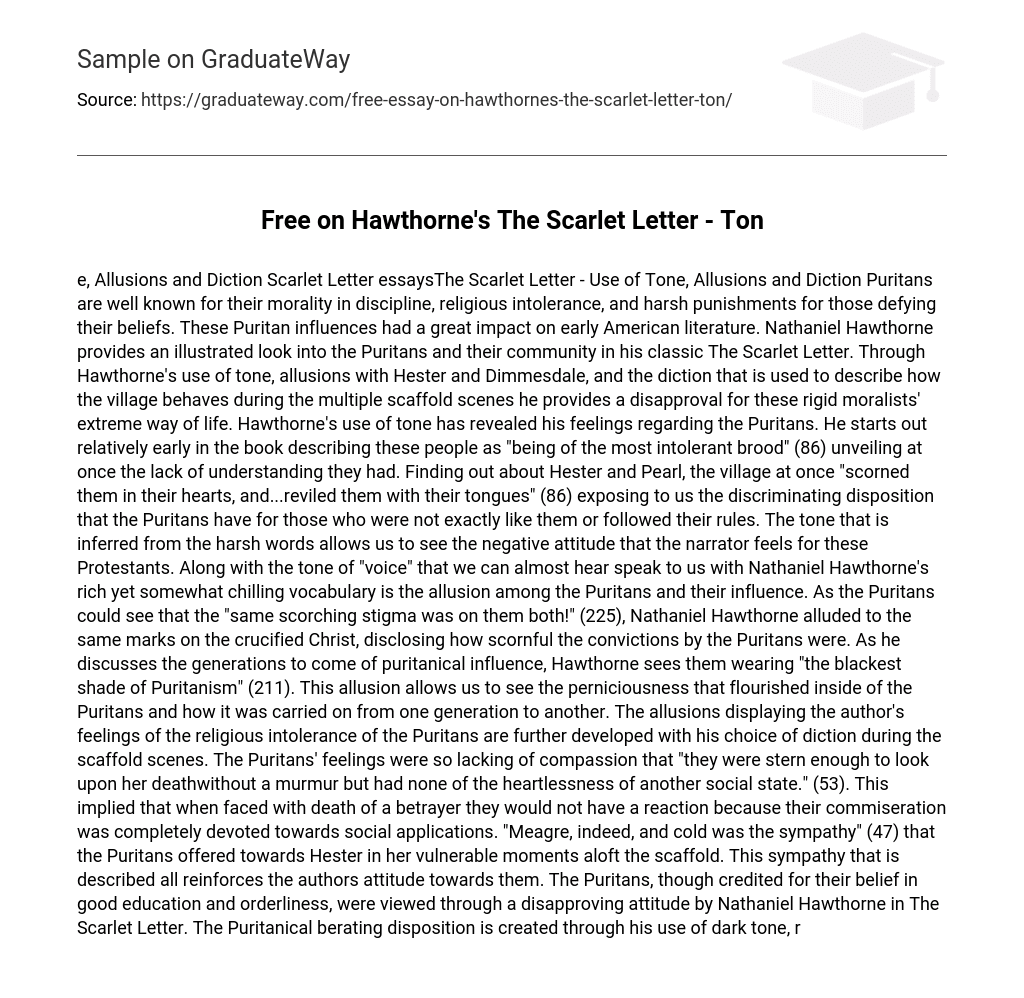e, Allusions and Diction Scarlet Letter essaysThe Scarlet Letter – Use of Tone, Allusions and Diction Puritans are well known for their morality in discipline, religious intolerance, and harsh punishments for those defying their beliefs. These Puritan influences had a great impact on early American literature. Nathaniel Hawthorne provides an illustrated look into the Puritans and their community in his classic The Scarlet Letter. Through Hawthorne’s use of tone, allusions with Hester and Dimmesdale, and the diction that is used to describe how the village behaves during the multiple scaffold scenes he provides a disapproval for these rigid moralists’ extreme way of life. Hawthorne’s use of tone has revealed his feelings regarding the Puritans. He starts out relatively early in the book describing these people as “being of the most intolerant brood” (86) unveiling at once the lack of understanding they had.
Finding out about Hester and Pearl, the village at once “scorned them in their hearts, and…reviled them with their tongues” (86) exposing to us the discriminating disposition that the Puritans have for those who were not exactly like them or followed their rules. The tone that is inferred from the harsh words allows us to see the negative attitude that the narrator feels for these Protestants. Along with the tone of “voice” that we can almost hear speak to us with Nathaniel Hawthorne’s rich yet somewhat chilling vocabulary is the allusion among the Puritans and their influence. As the Puritans could see that the “same scorching stigma was on them both!” (225), Nathaniel Hawthorne alluded to the same marks on the crucified Christ, disclosing how scornful the convictions by the Puritans were.
As he discusses the generations to come of puritanical influence, Hawthorne sees them wearing “the blackest shade of Puritanism” (211). This allusion allows us to see the perniciousness that flourished inside of the Puritans and how it was carried on from one generation to another. The allusions displaying the author’s feelings of the religious intolerance of the Puritans are further developed with his choice of diction during the scaffold scenes. The Puritans’ feelings were so lacking of compassion that “they were stern enough to look upon her deathwithout a murmur but had none of the heartlessness of another social state.” (53). This implied that when faced with death of a betrayer they would not have a reaction because their commiseration was completely devoted towards social applications. “Meagre, indeed, and cold was the sympathy” (47) that the Puritans offered towards Hester in her vulnerable moments aloft the scaffold.
This sympathy that is described all reinforces the authors attitude towards them. The Puritans, though credited for their belief in good education and orderliness, were viewed through a disapproving attitude by Nathaniel Hawthorne in The Scarlet Letter. The Puritanical berating disposition is created through his use of dark tone, religious and evil allusions of Hester and Dimmesdale, and the diction chosen to describe Hester’s torment atop the scaffold. Through the author’s suggested attitudes we, the readers, can see that social allegiance can sometimes mean the abandonment of good morals like caring for your fellow citizen.





